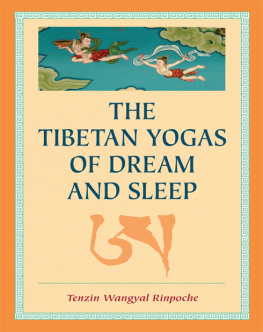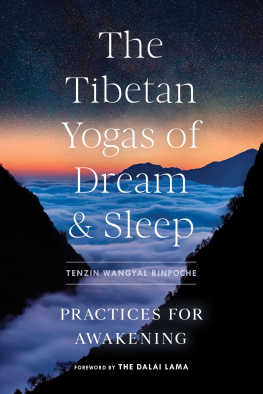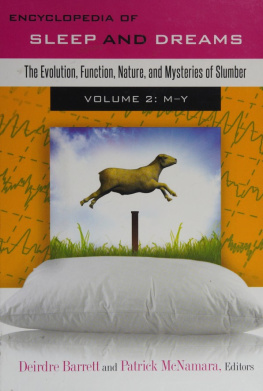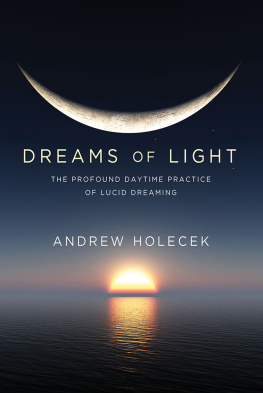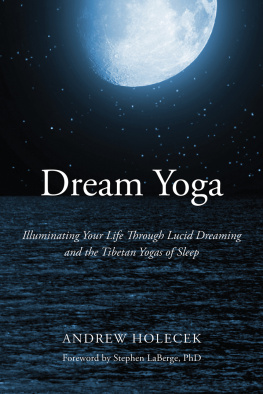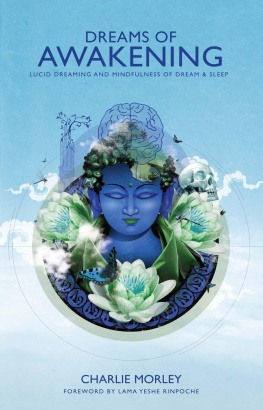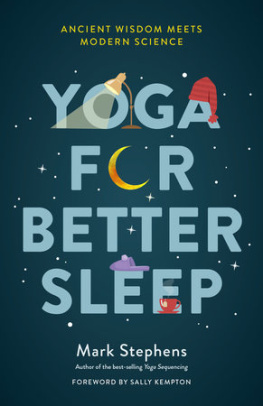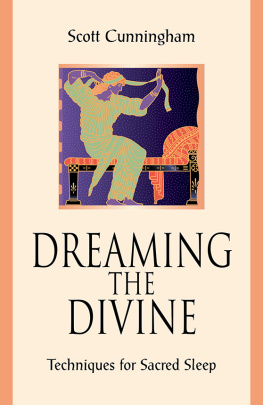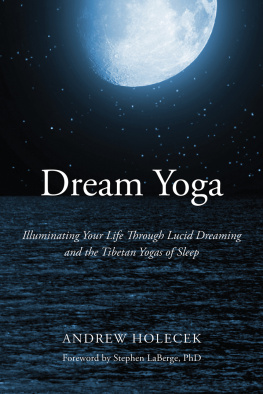Dahlby Mark - The Tibetan Yogas of Dream and Sleep
Here you can read online Dahlby Mark - The Tibetan Yogas of Dream and Sleep full text of the book (entire story) in english for free. Download pdf and epub, get meaning, cover and reviews about this ebook. City: Ithaca;NY;Tibet, year: 1998, publisher: Shambhala;Snow Lion Publications, genre: Religion. Description of the work, (preface) as well as reviews are available. Best literature library LitArk.com created for fans of good reading and offers a wide selection of genres:
Romance novel
Science fiction
Adventure
Detective
Science
History
Home and family
Prose
Art
Politics
Computer
Non-fiction
Religion
Business
Children
Humor
Choose a favorite category and find really read worthwhile books. Enjoy immersion in the world of imagination, feel the emotions of the characters or learn something new for yourself, make an fascinating discovery.
- Book:The Tibetan Yogas of Dream and Sleep
- Author:
- Publisher:Shambhala;Snow Lion Publications
- Genre:
- Year:1998
- City:Ithaca;NY;Tibet
- Rating:4 / 5
- Favourites:Add to favourites
- Your mark:
- 80
- 1
- 2
- 3
- 4
- 5
The Tibetan Yogas of Dream and Sleep: summary, description and annotation
We offer to read an annotation, description, summary or preface (depends on what the author of the book "The Tibetan Yogas of Dream and Sleep" wrote himself). If you haven't found the necessary information about the book — write in the comments, we will try to find it.
The Tibetan Yogas of Dream and Sleep — read online for free the complete book (whole text) full work
Below is the text of the book, divided by pages. System saving the place of the last page read, allows you to conveniently read the book "The Tibetan Yogas of Dream and Sleep" online for free, without having to search again every time where you left off. Put a bookmark, and you can go to the page where you finished reading at any time.
Font size:
Interval:
Bookmark:

T HE T IBETAN Y OGAS
OF D REAM AND S LEEP
Tenzin Wangyal Rinpoche
Edited by
Mark Dahlby
Snow Lion Publications
Ithaca, New York
Snow Lion Publications
P.O. Box 6483
Ithaca, New York 14851 USA
607-273-8519
Copyright 1998 Tenzin Wangyal
First edition USA 1998
All rights reserved. No portion of this work may be reproduced by any means without prior written permission from the publisher.
ISBN-13:978-1-55939-101-6
Library of Congress Cataloging-in-Publication Data
Wangyal, Tenzin.
Tibetan yogas of dream and sleep / Tenzin Wangyal Rinpoche ; edited by Mark Dahlby.
p. cm
Includes bibliographical references
ISBN 1-55939-101-4
1. Yoga (Bonpo) 2. DreamsReligious aspectsBonpo (Sect) 3. SleepReligious aspectsBonpo (Sect) I. Dahlby mark. II. Title.
BQ7982.2.W36 1998
294.34446dc21
98-23380
CIP
This book is dedicated to Namkhai Norbu Rinpoche,
who has been a great inspiration in my life,
both in how I teach others and in my own practice.
I want to thank the people who have been instrumental in bringing this book to publication. First of all, and most importantly, Mark Dahlby, my student and close friend, with whom I greatly enjoyed working. We spent many hours discussing different issues in cafes around Berkeley. Without him, this book would not have been possible.
Also: Steven D. Goodman, a colleague and friend, improved the manuscript through numerous good suggestions; Sue Ellis Dyer and Chris Baker made editing suggestions on an early version of the book; Sue Davis and Laura Shekerjian helped by reading the text and offering feedback; and Christine Cox of Snow Lion Publications brought her great skill as an experienced editor to the text and made it a much better book.
The photographs of the meditation and dream yoga positions, on pages 85 and 109 respectively, were taken by Antonio Riestra and modeled by Luz Vergara. The illustrations of the chakras on pages 105 and 107 were created by Monica R. Ortega. I also want to thank all those I have not named but who have helped in many different ways.
A well-known saying in Tibetan states, One should explain the lineage and the history in order to cut doubt about the authenticity of the teaching and the transmission. Therefore, I begin this book with a short story of my life.
I was born shortly after my parents fled the Chinese oppression in Tibet. Conditions were difficult and my parents placed me in a Christian boarding school, where they hoped I would be cared for. My father was a Buddhist lama*, my mother a practitioner of Bn*. Some time after, my father died. Eventually my mother remarried a man who was a Bn lama. Both he and my mother desired that I live within my culture, and when I was ten years old I was taken to the main Bn monastery in Dolanji, India, and ordained as a monk.
After living in the monastery for some time, I was recognized by Lopon (Head Teacher) Sangye Tenzin Rinpoche as the reincarnation of Khyungtul Rinpoche, a famous scholar, teacher, author, and meditation master. He was well known as a master astrologer, and in western Tibet and northern India was famous as a tamer of wild spirits. He was widely sought after as a healer with magical abilities. One of his sponsors was a focal king of Himachal in Northern India. This king and his wife, unable to bear children, asked Khyungtul Rinpoche to heal them, which he did. The son that they bore and raised is the present day Chief Minister of Himachal Pradesh, Virbhardur.
When I was thirteen, my kind root master, Lopon Sangye Tenzin, a man of great knowledge and realization, prepared to teach one of the most important and esoteric teachings in the Bn religion: the Great Perfection ( Dzogchen*) lineage of the Oral Transmission of Zhang Zhung (Zhang Zhung Nyan Gyud*). Even though I was still young, my step-father visited Lopon Rinpoche and asked that I be admitted to the teachings, which would take place every day for three years. Lopon kindly agreed, but asked that I, along with the other prospective students, bring him a dream from the night before the teachings were to begin, so that he might determine our readiness.
Some of the students remembered no dream, which was considered a sign of obstacles. Lopon had them begin appropriate purification practices and delayed the beginning of the teaching until each student did have a dream. Dreams of other students were taken as indications that they needed to do particular practices to ready themselves for the teachingsfor example, doing practices that strengthened their connections to the Bn guardians*.
I dreamt about a bus circumambulating my teachers house, although there is actually no road there. In the dream, the bus conductor was my friend and I stood beside him, handing out tickets to each person that boarded the bus. The tickets were pieces of paper that had the Tibetan syllable A written on them. That was in the second or third year of my education at Dolanji, when I was thirteen years old, and at the time I did not know that A was a symbol of major significance in Dzogchen teachings. My teacher never said anything about the dream, which was his way. He made little comment about what was good, but I was happy as long as I was allowed to come to the teachings.
It is common, in Tibetan spiritual traditions, for dreams of the students to be used by the teacher in this fashion to determine if it is appropriate for a student to receive a particular teaching. Though it would be some time before I began to study and practice dream yoga, this incident was the beginning of my interest in dreams. It strongly impressed on me how greatly dream is valued in Tibetan culture and in the Bn religion, and how information from the unconscious is often of greater value than the information the conscious mind can provide.
After the three-year teaching, which included numerous meditation retreats with my fellow practitioners as well as many retreats that I did alone, I entered the monastic Dialectic School. The program of study normally takes nine to thirteen years to complete and covers the traditional training. We were taught the common academic subjects, such as grammar, Sanskrit, poetry, astrology, and art, and also learned the uncommon subjects: epistemology, cosmology, sutra*, tantra* and Dzogchen. During the monastic training, I was exposed to a number of teachings and transmissions on dream, the most important based on the texts of the Zhang Zhung Nyan Gyud, the Mother Tantra, and of Shardza Rinpoche.
I did well in the training and when I was nineteen I was asked to begin teaching others, which I did. Around the same time I wrote and published a summary of the biography of Lord Shenrab Miwoche*, the founder of the Bn religion. Later I became the president of the Dialectic School and held that position for four years, and was very involved in shaping and developing the school. In 1986, I received the Geshe degree, the highest degree awarded in Tibetan monastic education.
In 1989, at the invitation of Namkhai Norbu Rinpoches Dzogchen Community in Italy, I traveled to the West. Although I had no plans to teach, I was invited to do so by members of the community. One day I was passing out small pieces of paper to be used in a meditation on concentration. Each piece of paper had the Tibetan syllable A written on it. Right then the dream from fifteen years before, in which I passed out the same paper to people getting on the bus, came back to me. It was as if it hit me on the head.
I remained in the West and in 1991 was awarded a Rockefeller Fellowship to do research at Rice University. In 1993, I published my first book in the West, The Wonders of the Natural Mind , in which I tried to present the Great Perfection (Dzogchen) teachings in a clear and simple way. In 1994 I was given a grant from The National Endowment for the Humanities to pursue research on the logical and philosophical aspects of the Bn tradition, in collaboration with Professor Anne Klein, Chair of Religious Studies, at Rice University.
Font size:
Interval:
Bookmark:
Similar books «The Tibetan Yogas of Dream and Sleep»
Look at similar books to The Tibetan Yogas of Dream and Sleep. We have selected literature similar in name and meaning in the hope of providing readers with more options to find new, interesting, not yet read works.
Discussion, reviews of the book The Tibetan Yogas of Dream and Sleep and just readers' own opinions. Leave your comments, write what you think about the work, its meaning or the main characters. Specify what exactly you liked and what you didn't like, and why you think so.

